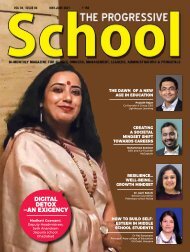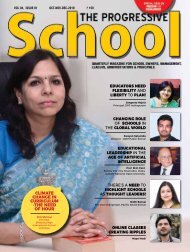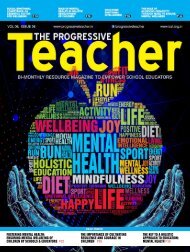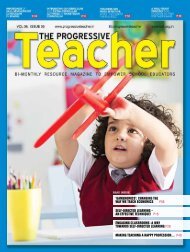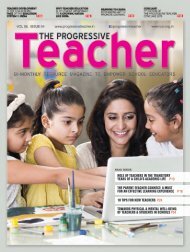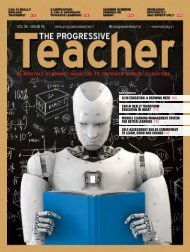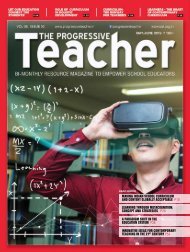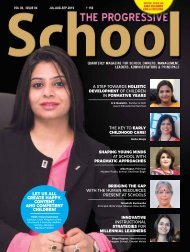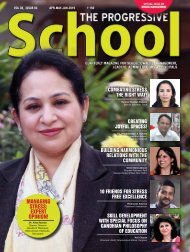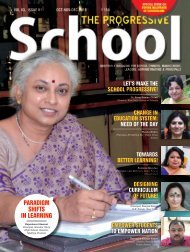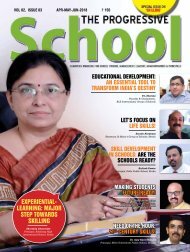The Progressive Teacher Vol 04 Issue 03
This issue of The Progressive Teacher focuses on "New Trends in Education ". In this edition, articles explore contemporary trends to enhance interactive learning amongst students.
This issue of The Progressive Teacher focuses on "New Trends in Education ". In this edition, articles explore contemporary trends to enhance interactive learning amongst students.
You also want an ePaper? Increase the reach of your titles
YUMPU automatically turns print PDFs into web optimized ePapers that Google loves.
creativity<br />
–Preeti Sunderajan<br />
Imagine a birthday party of a<br />
three year old. <strong>The</strong>re is lots<br />
of colour, balloons, laughter,<br />
music and movement. At one<br />
such joyous occasion, Rhea’s<br />
mother first noticed that her<br />
child needed some additional<br />
attention. While all children<br />
jumped and rolled to music, Rhea<br />
remained seated at the back with<br />
her gaze downward. It was as if<br />
she just wasn’t letting the music<br />
move her. Rhea’s mother noticed<br />
this pattern on several occasions<br />
where Rhea preferred being in<br />
the background, nearly invisible.<br />
So she decided to enroll Rhea in<br />
a creative movement class. <strong>The</strong><br />
objective of putting her in this<br />
class was to increase her social<br />
skills. Her parents thought that if<br />
she interacted with other children<br />
of her age she may get positively<br />
influenced. After a few months of<br />
classes, the impact and change<br />
was very evident. Rhea was<br />
now confident, outgoing, funloving<br />
and social. She got very<br />
comfortable with herself, made<br />
friends easily and started dancing<br />
in parties. This was thirteen years<br />
ago. Today, Rhea is a classical<br />
dancer, a basketball player and<br />
enjoys creative writing.<br />
<strong>The</strong>re could be several reasons<br />
why Rhea did not participate in<br />
dancing activity at parties. This<br />
could include lack of confidence,<br />
limited movement vocabulary,<br />
difficulty in body and movement<br />
control, poor self-image, or<br />
fear of being judged. Directly<br />
Creative Movement<br />
in Education<br />
Body movement and performing arts as a medium of expression to groom<br />
and teach children lessons for life<br />
Movement sessions are ideal environments for learning in multiple ways.<br />
It can help one understand the relationship of ones body with space and<br />
time and make deeper connections by enhancing learning capacities.<br />
or indirectly creative movement<br />
deals with these attributes. <strong>The</strong><br />
fundamental principle is mindbody<br />
connection.<br />
Movement sessions are ideal<br />
environments for learning in<br />
multiple ways. It can help one<br />
understand the relationship of<br />
ones body with space and time<br />
and make deeper connections by<br />
enhancing learning capacities. By<br />
adding aesthetics and meaning to<br />
movement we make it a means<br />
of self-expression thus bringing<br />
about a mind body connect. <strong>The</strong><br />
medium of performing arts is<br />
a wonderful form of expression<br />
where the performer is able to<br />
make connections between art,<br />
culture/ life and society.<br />
How do we use performing arts<br />
to move beyond the scope of<br />
mere entertainment then?<br />
In order for us to make<br />
connections between movement,<br />
dance forms, learning and<br />
expression, we have to<br />
understand the process of<br />
creation versus the end result<br />
(which in the case of dance<br />
will be a dance performance).<br />
It becomes important to<br />
understand and mediate a<br />
process that bridges performing<br />
arts and self development. <strong>The</strong><br />
essence of Indian performing<br />
arts is the ability to tell stories<br />
through your eyes, face, gestures<br />
and body, the ability to multi<br />
task with different body parts<br />
and the ability to perform using<br />
all this to complex rhythmic<br />
patterns. All this leads to a<br />
good performance but if we can<br />
remove the technical side of<br />
creative movement, we can see it<br />
having a much larger impact on<br />
the personality. A few questions<br />
that come to my mind are: How<br />
do we break this down? How<br />
do we move from imitation to<br />
innovation?<br />
This can be broken down if<br />
we give more importance<br />
to the process of creation<br />
versus the end result. While<br />
creating a piece of art we<br />
use skills like visualisation,<br />
articulation of thoughts and<br />
ideas, communication using the<br />
body as a medium of expression,<br />
creative thinking, presence of<br />
mind, team work and most<br />
importantly creativity. Allowing<br />
the child to use the medium of<br />
dance not to learn by rote but to<br />
create something has a greater<br />
impact on the personality. This I<br />
found was the crux of Creative<br />
Movement and its impact on the<br />
child’s personality.<br />
Some of the areas that Creative<br />
Movement impacts are:<br />
• Self Esteem: Helps develop<br />
a positive self-concept in an<br />
8 <strong>The</strong> <strong>Progressive</strong> <strong>Teacher</strong> Jul/Aug 2017




